
The Solar-Terrestrial Centre of Excellence (STCE) is a collaborative network of the Belgian Institute for Space Aeronomy, the Royal Observatory of Belgium and the Royal Meteorological Institute of Belgium.
 |
Published by the STCE - this issue : 20 Feb 2015. The Solar-Terrestrial Centre of Excellence (STCE) is a collaborative network of the Belgian Institute for Space Aeronomy, the Royal Observatory of Belgium and the Royal Meteorological Institute of Belgium. |
| Archive of the newsletters | Subscribe to this newsletter by mail |
It's a good day when, within the space of 10 hours, two satellites successfully get launched. That's indeed what happened on 11 February when first, at 13:40UT, the Intermediate eXperimental Vehicle (IXV) lifted off with a Vega rocket from French Guyana. This was quickly followed by the launch of the Deep Space Climate Observatory (DSCOVR), lifting off at 23:03UT with a Falcon rocket from Cape Canaveral, Florida.
IXV is an experimental project to provide Europe with an autonomous re-entry capability for future reusable space transportation. The vehicle looks like a wingless plane, has the size of a car, and the weight of a rhino. Hitchhiking the VEGA rocket to a height of 340 km, the unmanned craft then flew all by itself to a maximum altitude of 412 km, which is slightly higher than the operating altitude of the International Space Station. From there, it graciously glided through the Earth's atmosphere withstanding scorching temperatures up to 1700 degrees before successfully splashing down in the Pacific awaiting recovery. During its 100 minutes flight, sensors and cameras were gathering data of the technologies that were tested, for further study and integration into the ongoing project.
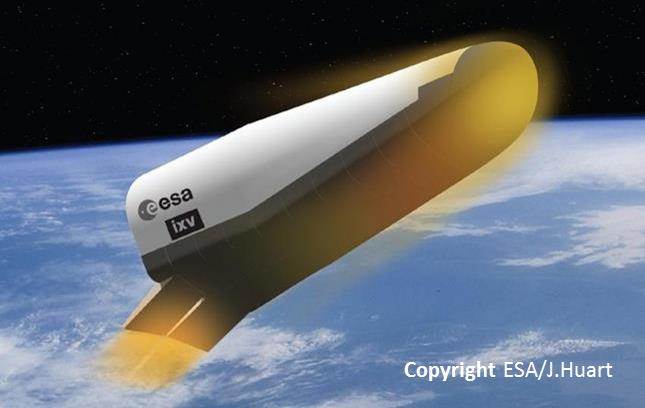
Interestingly, Europe's Space weather Coordination Centre (SSCC) in Brussels, Belgium, provided the Space Weather support for this mission. Based on input from BISA (http://www.aeronomie.be/en/organisation/solarwind.htm) and the Regional Warning Centre (RWC - http://www.sidc.be/index.php) in Brussels, three space weather reports were sent, with the last one just hours before the actual launch. Each of the reports focused on solar flaring activity and any possible proton increases. Such events are known to cause communication problems and glitches in the electronics. Fortunately, the Sun behaved and did not unleash any strong eruption, perfectly in accordance with the forecasts.
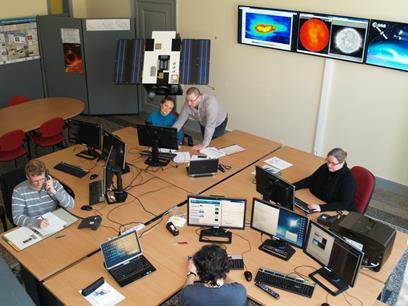
Hardly recovered from this adrenaline pumping mission, space enthusiasts got treated to the launch of a very important satellite. Indeed, it is little known that all our realtime knowledge of the solar wind depends pretty much on a single satellite, the Advanced Composition Explorer (ACE). Launched on 25 August 1997, its nominal lifetime was initially set at 5 years. As it turns out, ACE has survived the Sun's furies for a much longer time than that. It is still very much alive and operational, having become a critical asset in the domain of space weather forecasting. As it would be risky business to count on this craft lasting for another 5 to 10 years, a suitable replacement has been developed by NOAA, NASA and USAF. This is the DSCOVR mission, and it will measure all kinds of solar wind features from the same vantage point as ACE, 1.5 million km upstream between the Earth and the Sun. DSCOVR is expected to get there within about 110 days, after which it will have to complete a series of initialization checks. It is hoped that within 150 days (let's say during the summer holidays) the satellite will be fully operational and become the prime solar wind satellite. From this crow's nest (officially called Lagrange-1 point), DSCOVR will then act as the ultimate warning post for the imminent approach of any coronal mass ejection.
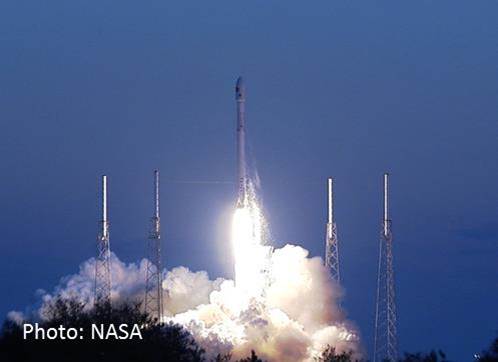
Unlike ACE, DSCOVR will also have the capability to observe the Earth. It has two dedicated instruments to do this: EPIC (Earth Polychromatic Imaging Camera) and NISTAR (National Institute of Standards and Technology Advanced Radiometer). EPIC will take pictures from the sunlit face of the Earth in 10 narrow wavelength bands ranging from the ultra violet to the near infrared. Imagery taken by this 30.5 cm Cassegrain telescope will allow research on aerosols, ozone, and cloud height. NISTAR is built to measure the irradiance of the sunlit face of the Earth. This data is to be used to study changes in Earth's radiation budget caused by natural and human activities. Hence, it is expected that both instruments will make valuable contributions to Earth's climate studies.
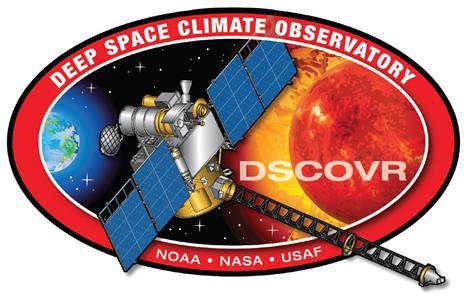
More information on IXV can be found at ESA's http://www.esa.int/Our_Activities/Launchers/IXV/, and on DSCOVR at NOAA's http://www.nesdis.noaa.gov/DSCOVR/
Solar activity has been relatively quiet over the last week, with one M class flare and one halo CME observed. At the start of the week the solar disk exhibited four NOAA active regions (AR); 2277, 2280, 2281 and 2282. These all remained relatively stable with small amounts of flux emergence over the whole week. As the week progressed AR 2283 emerged near disk center on 2015-Feb-13, the region remained small and stable following it's emergence.
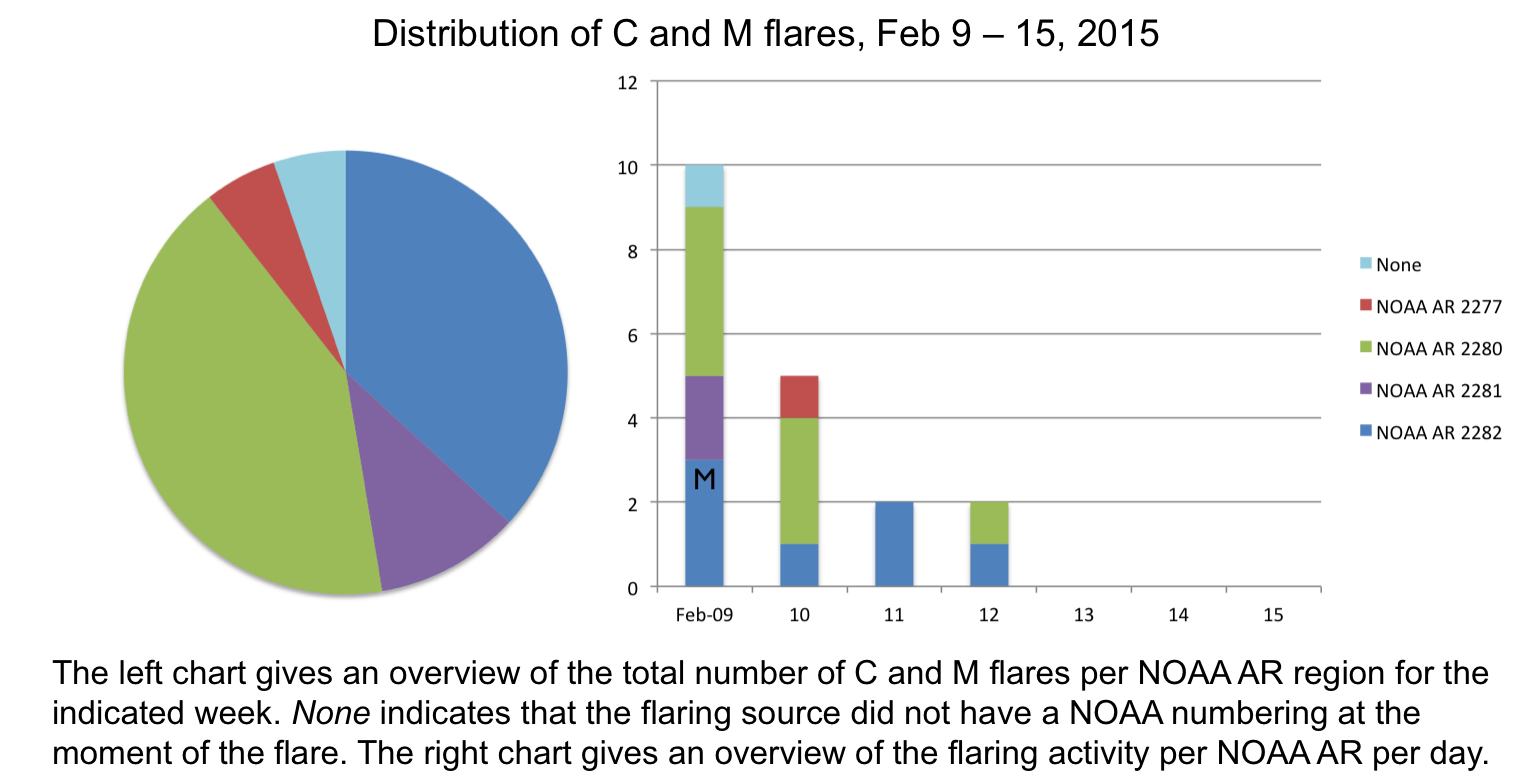
ARs 2280 and 2281 passed out of view over the Western limb and AR 2284 came into view on the Eastern limb. Throughout the week flaring was concentrated around the C and B class flares. AR 2282 was most active and produced the largest flare, an M2.4 flare on 2015-Feb-09 peaking at 23:35 UTC. AR 2280 produced the second most energetic flare a C6.0 class flare on 2015-Feb-12 peaking at 02:12 UTC. The M2.4 flare was associated with a halo CME first observed in LASCO-C2 coronagraphs at 23:24 UT on 2015-Feb-09 and the main component propagated to the East with an estimated velocity of approximately 1000 km/s. The pictures below are taken by the coronagraph LASCO/C2 (Red) and C3 (Blue) onboard SOHO. The grey images are difference images and allow a clear view on the CME.
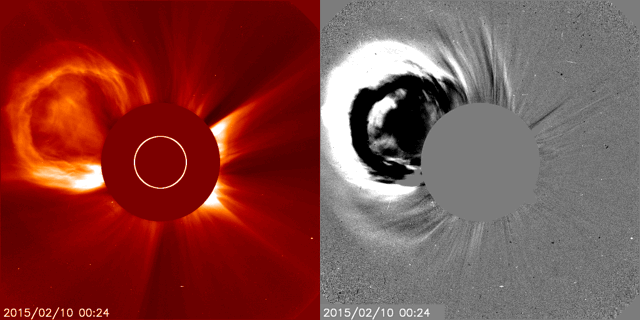
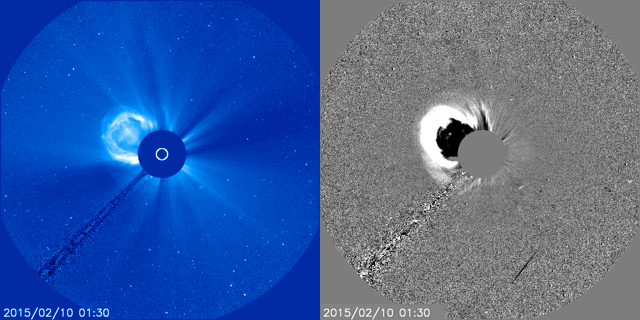
It was initially thought that the CME may have been geo-effective, but there was no evidence of the CME interacting with the Earth system.
Throughout the week a large filament rotated across the Southern hemisphere, but it remained stable. It is indicated with the green arrows on the H-alpha BBSO image.
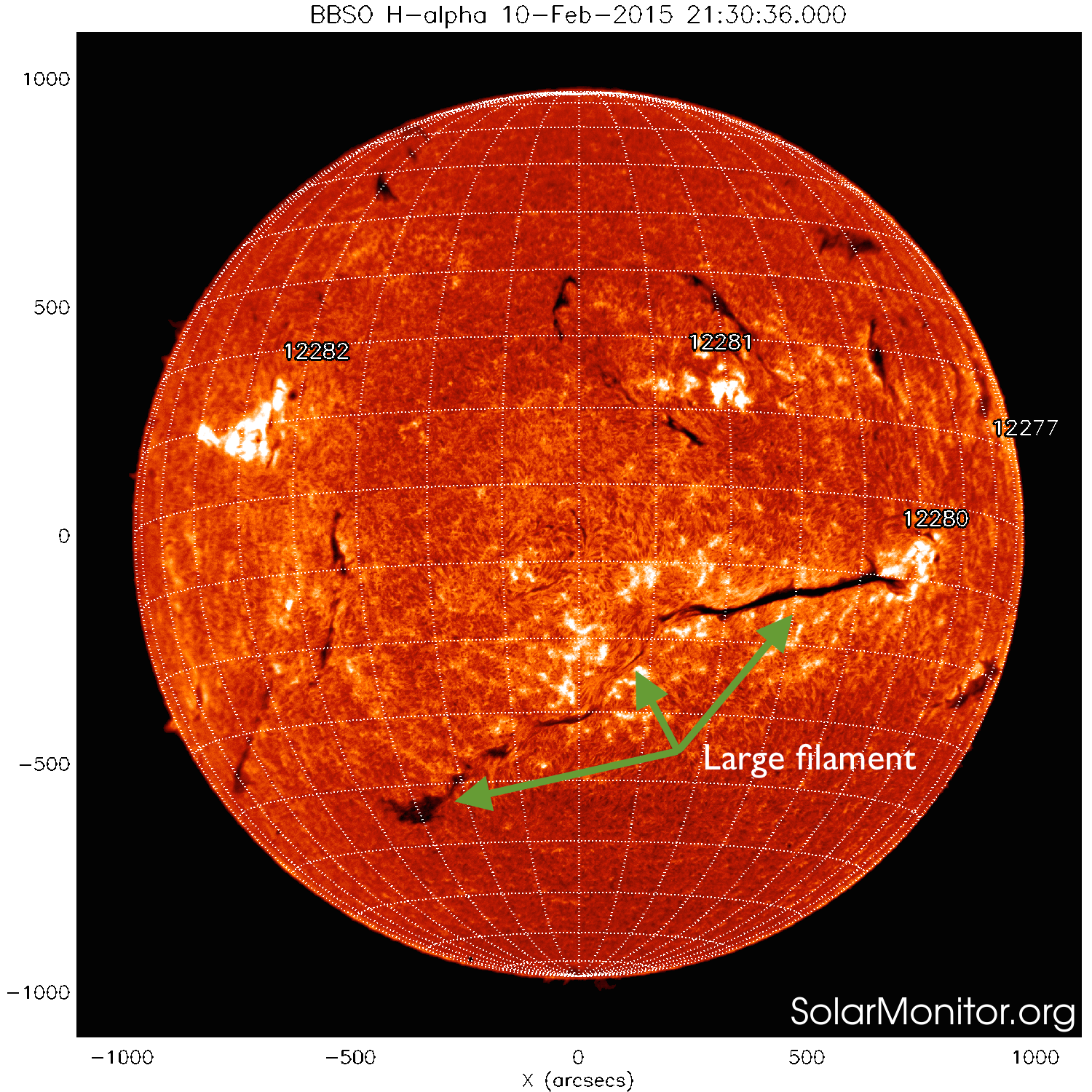
A coronal hole also rotated into the Western hemisphere, but as of 2015-Feb-15 there was no signature of high speed solar wind streams reaching Earth.
Several back-sided CMEs were observed off of the Eastern solar limb, which may indicate a more active period over the next couple of weeks. The proton flux remained stable throughout the week.
| DAY | BEGIN | MAX | END | LOC | XRAY | OP | 10CM | TYPE | Cat | NOAA |
| 09 | 2302 | 2335 | 0012 | M2.3 | ||||||
| 09 | 2219 | 2335 | 0016 | S8W33 | M2.4 | SF | VI/1 | 2282 | ||
| 09 | 2259 | 2335 | 0014 | M2.4 | VI/1 | 2282 |
| LOC: approximate heliographic location | TYPE: radio burst type |
| XRAY: X-ray flare class | Cat: Catania sunspot group number |
| OP: optical flare class | NOAA: NOAA active region number |
| 10CM: peak 10 cm radio flux |
The solar wind remained relatively constant over the whole week, with speeds remaining largely constant with a small decline from 400 to 350 km/s. The total magnetic field has been stable around 6 nT, however the Bz component has been variable, ranging between +5 and -5 nT. A short drop in the magnetic field, and a subsequent rotation in the phi angle was observed on 2015-Feb-15 due to the passing of a sector boundary. Geomagnetic conditions were quiet to moderate over the whole week (NOAA Kp 0-3, local K Dourbes 0-3).
The top graph shows the solar wind speed, the second graph shows the total and Bz component of the interplanetary magnetic field (IMF) and the bottom panel the phi angle over the course of the week. All there parameters are measured by the satellite ACE in the L1 point. The angle phi says if the IMF is pointing inwards of outwards as can be deduced from the cartoon given a top view on the ecliptic plane with the yellow sun and pink/red IMF lines.
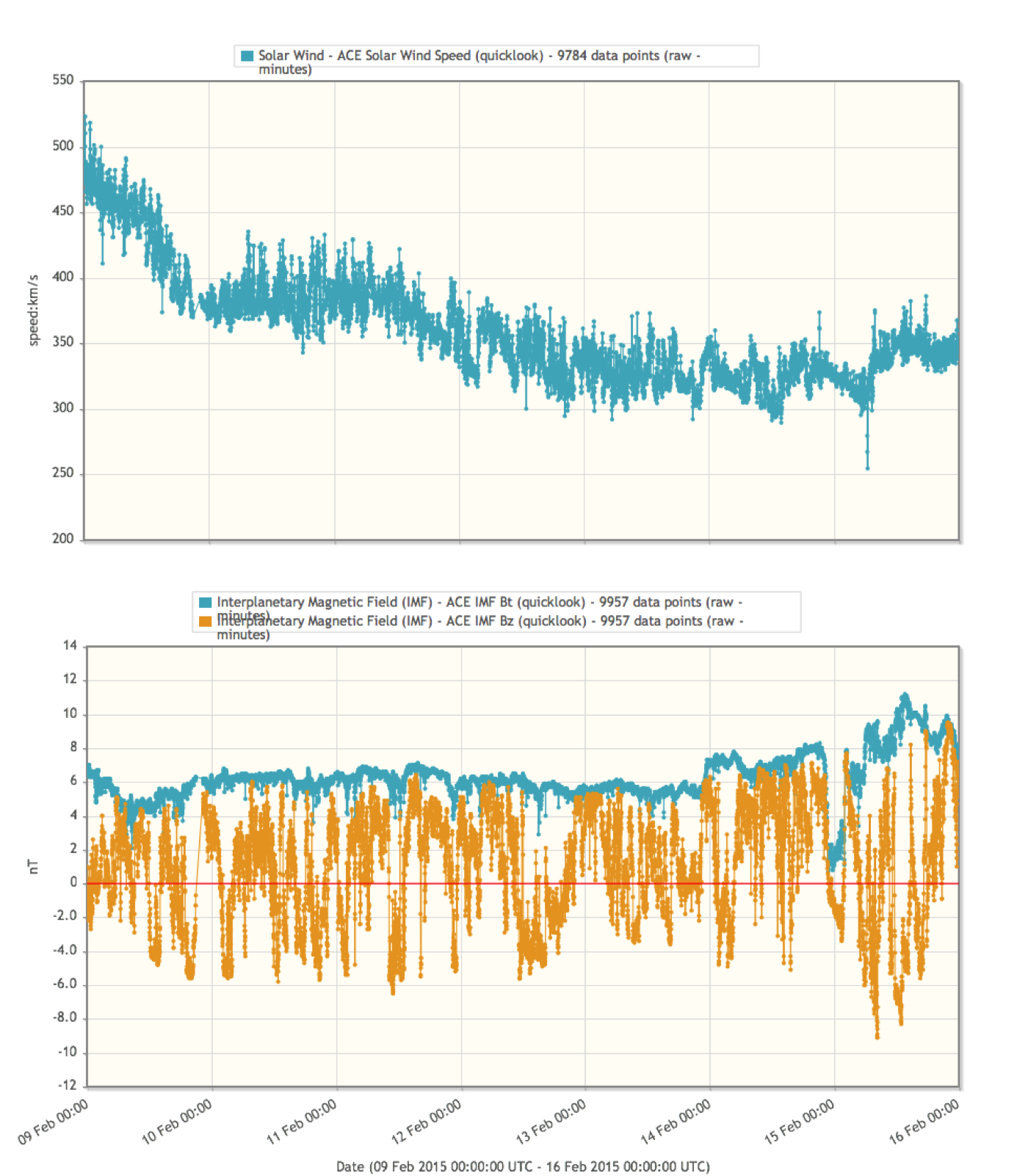
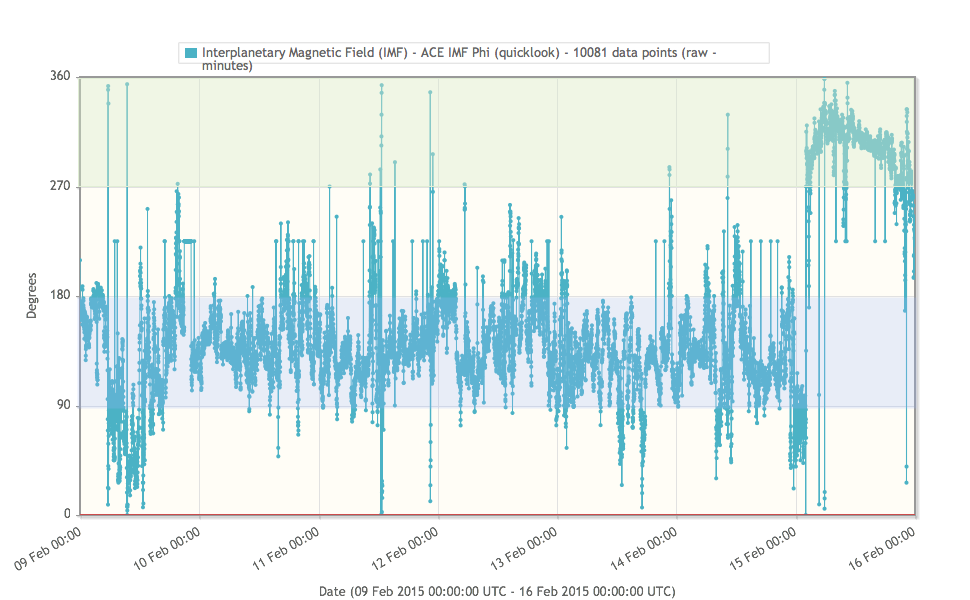
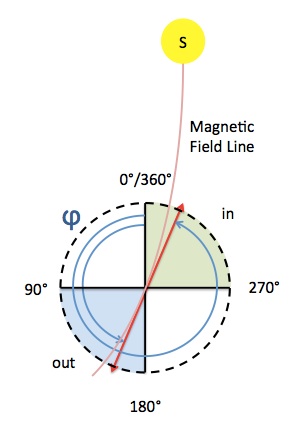
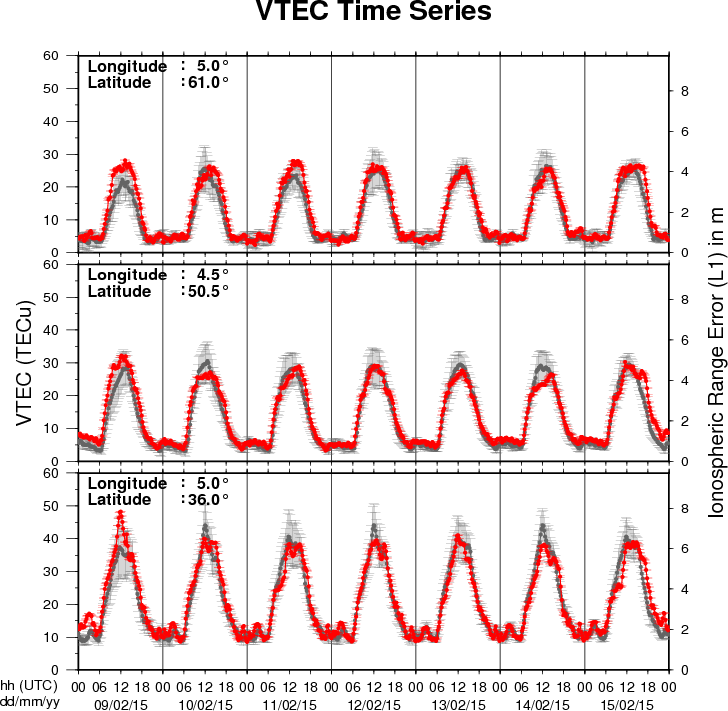
The figure shows the time evolution of the Vertical Total Electron Content (VTEC) (in red) during the last week at three locations:
a) in the northern part of Europe(N61°, 5°E)
b) above Brussels(N50.5°, 4.5°E)
c) in the southern part of Europe(N36°, 5°E)
This figure also shows (in grey) the normal ionospheric behaviour expected based on the median VTEC from the 15 previous days.
The VTEC is expressed in TECu (with TECu=10^16 electrons per square meter) and is directly related to the signal propagation delay due to the ionosphere (in figure: delay on GPS L1 frequency).
The Sun's radiation ionizes the Earth's upper atmosphere, the ionosphere, located from about 60km to 1000km above the Earth's surface.The ionization process in the ionosphere produces ions and free electrons. These electrons perturb the propagation of the GNSS (Global Navigation Satellite System) signals by inducing a so-called ionospheric delay.
See http://stce.be/newsletter/GNSS_final.pdf for some more explanations ; for detailed information, see http://gnss.be/ionosphere_tutorial.php
Start : 2015-03-16 - End : 2015-03-19
This international conference will provide an overview of our
current understanding of Sun-Climate Connections starting at
processes on the Sun itself over space weather and solar wind
towards solar influence on the upper atmosphere down to the ocean.
It will also provide insights into the heatedly debated role of the
Sun in climate change. In four sessions the various contributions
of solar variability influence on Earth's climate will be presented
and discussed by bringing together solar physicists, space
scientists, atmospheric scientists, climate modellers, and
paleoclimatologists.
We expect contributions from scientists participating in
SCOSTEP/ROSMIC, SPARC-SOLARIS/HEPPA, the EU cost network TOSCA, as
well as any other interested scientists. The conference will last
three full days, beginning Monday morning, 16 March 2013. The
programme will consist of invited and keynote lectures, a few
contributed oral presentations and ample time dedicated to poster
sessions. The fourth day will be devoted to public outreach
activities as well as panel discussions.
Website: http://scc.geomar.de/
Start : 2015-05-18 - End : 2015-05-22
URSI AT-RASC 2015 will be the first edition of the newly
established triennial URSI Atlantic Radio Science Conference as one
of the URSI Flagship Conferences. AT-RASC 2015 will have an open
scientific program composed of submitted papers within the domains
covered by all ten Commissions of URSI.
Website: http://www.at-rasc.com/
Start : 2015-05-25 - End : 2015-05-29
25-27 May 2015: BUKS 2015 - MHD waves: Observational aspects
from ground to space - MHD waves: Theory - where are we? - MHD
instabilities
27-28 May 2015: Ruderman Honorary meeting - Theory of linear MHD
waves - MHD waves instabilities - Non-linear waves in plasmas
29 May 2015: Joint BUKS/Ruderman's conferences excursion -
Boat excursion to Szentendre, Visegrad and Esztergom
Website:
http://swat.group.shef.ac.uk/Conferences/BUKS_2015/index.html
Start : 2015-06-01 - End : 2015-07-24
The Space Weather Summer School at Los Alamos National
Laboratory, established in 2011 under the founding Director Josef
Koller, is dedicated to space weather, space science and
applications. Every year we solicit applications for the Los Alamos
Space Weather Summer School. This summer school is sponsored and
supported by a number or organizations at LANL. This year our top
sponsors include the Los Alamos Institute of Geophysics, Planetary
Physics and Signatures (IGPPS) and the Laboratory Directed Research
and Development Office (LDRD). The summer school brings together
top space science students with internationally recognized
researchers at LANL in an educational and collaborative
atmosphere.
Website:
http://www.swx-school.lanl.gov/
Start : 2015-06-09 - End : 2015-06-12
The last five years have seen substantial progress in our
understanding of the solar dynamo, fueled by continuing advances in
observations and modeling. With the launch of NASA's Solar Dynamics
Observatory (SDO) in 2010 came an unprecedented window on the
evolving magnetic topology of the Sun, highlighting its intricate
3D structure and global connectivity. The Helioseismic Magnetic
Imager (HMI) instrument on SDO in particular has provided
potentially transformative yet enigmatic insights into the internal
dynamics of the solar convection zone that underlie the dynamo.
Attempts to detect subsurface convective motions from helioseismic
inversions have yielded only upper limits on the large-scale
convective amplitude, challenging our understanding of global solar
convection. Yet, potential signatures of giant cells have been
detected in photospheric Dopplergrams. Estimates of the meridional
flow from HMI and complementary instruments (SOHO/MDI and GONG)
have been equally tantalizing and enigmatic. Several disparate
techniques, including local and global helioseismic inversions and
correlation tracking of surface features, have yielded evidence of
a multi-cellular meridional flow but they differ on the detailed
flow structure and amplitude. This multi-cellular meridional flow
has potentially profound implications for flux-transport dynamo
models that previously assumed a very different structure with a
single circulation cell per hemisphere.
Website:
https://www2.hao.ucar.edu/Workshop/Solar-Dynamo-Frontiers
Start : 2015-07-13 - End : 2015-07-24
The CISM Summer School is intended to give students a
comprehensive immersion in the subject of space weather: what it
is, what it does, and what can be done about it. Space weather is
many things: beautiful when seen through the eyes of a sun-viewing
telescope, fascinating when studied for its alien worlds of
magnetic structures and phenomena, awesome when witnessed as a
solar eruption or auroral storm, and devastating to the users of
services it disrupts. Space weather links the Sun, the Earth, and
the space in between in a branching chain of consequences. Weather
systems on the Sun can spawn interplanetary storms of colossal size
and energy that envelop the whole planet in electrical hurricanes.
Such storms attack high-tech, complex, and expensive technological
systems that provide much of the infrastructure that allows modern
society to function.
Website:
https://www2.hao.ucar.edu/Events/2015-CISM-Summer-School
Start : 2015-07-21 - End : 2015-07-23
The conference will review past and recent achievements, as well
as future challenges in the field of solar coronal loop
physics.
Website:
http://www.damtp.cam.ac.uk/user/astro/cl7/index.html
Start : 2015-07-28 - End : 2015-08-04
Heliophysics is all of the science common to the field of the
Sun-Earth connections. This fast-developing field of research
covers many traditional sub-disciplines of space physics,
astrophysics, and climate studies. The NASA Living with a Star
program, with its focus on the basic science underlying all aspects
of space weather, acts as a catalyst to bring the many research
disciplines together to deepen our understanding of the system of
systems formed by the Sun-Earth connection.
Website:
http://www.heliophysics.ucar.edu/
Start : 2015-07-30 - End : 2015-08-06
The 34th International Cosmic Ray Conference (ICRC) will be held
from July 30 to August 6, 2015, in The Hague, The Netherlands. It
is an important and large conference in the field of Astroparticle
Physics. The ICRC covers: cosmic-ray physics, solar and
heliospheric physics, gamma-ray astronomy, neutrino astronomy, and
dark matter physics.
Website: http://icrc2015.nl
Start : 2015-08-31 - End : 2015-09-04
The purpose of this conference is to discuss the latest
questions and results in solar and stellar physics. Solar and
stellar seismology will be one particular focus but contributions
on all aspects of solar-stellar relations will be welcome. We aim
to establish links and synergies between the day- and night-time
fields of astrophysics.
Website:
http://www.iac.es/congreso/solarnet-3meeting/
Start : 2015-09-02 - End : 2015-09-04
The Workshop will address how the joint exploration of the
corona and inner heliosphere will lead to advances in our
understanding of coronal heating and solar wind acceleration, the
magnetic and plasma structure of the heliosphere, and the
acceleration of energetic particles at shocks and flares. The
workshop will inspire research that will make use of SO and SPP
observations within the context of the NASA Heliophysics
Observatory System and identify key areas for preparatory research.
Synergistic observations from other ground based and space based
assets will also be addressed.
Website:
http://www.solarprobeplus.org/2015/
Start : 2015-10-05 - End : 2015-10-09
This CSPM-2015 scientific meeting will cover various aspects of
solar dynamic and magnetic phenomena which are observed over the
entire electromagnetic spectrum: white-light, Hα, Ca II,
and radio from ground and in a variety of other wavelengths (white
light, UV and EUV, and X-rays) from space. Emphasis will also be
placed on instrumentation, observing techniques, and solar image
processing techniques, as well as theory and modelling through
detailed radiative transfer in increasingly realistic MHD models.
The long-term (cyclic) evolution of solar magnetism and its
consequence for the solar atmosphere, eruptive phenomena, solar
irradiation variations, and space weather, will be in focus. Here,
special attention will be devoted to the long-term observations
made in Coimbra and also to the results of the SPRING / SOLARNET
and SCOSTEP VarSITI studies. In particular, the weak solar activity
during the current solar maximum will be discussed. Finally, since
this meeting is organised around the 90th anniversary of performing
the first spectroheliographic observations in Coimbra, a session
will be specially dedicated to new solar instruments (both
ground-based and space-borne) that will give access to unexplored
solar atmospheric features and dynamic phenomena over the coming
years.
Website:
http://www.mat.uc.pt/~cspm2015/
Start : 2015-11-10 - End : 2015-11-13
Observations of the Sun and Earth from space have revolutionized
our view and understanding about impacts of solar variability and
anthropogenic forcing on Earth climate. For more than three solar
cycles since 1978, the total and spectral solar irradiance (TSI and
SSI) and global terrestrial atmosphere/surface have been observed
continuously, enabling unprecedented quality data for Sun-climate
studies. The primary objective of this symposium is to convene
climate scientists, solar physicists, and experimentalists together
for a better understanding how Earth climate system changes and
responds to solar variability.
Website:
http://lasp.colorado.edu/home/sorce/news-events/meetings/2015-sun-climate-symposium/
Start : 2016-07-30 - End : 2016-08-07
The 41st COSPAR Scientific Assembly will be held in Istanbul,
Turkey from 30 July - 7 August 2016. This Assembly is open to all
bona fide scientists.
Website:
https://www.cospar-assembly.org/